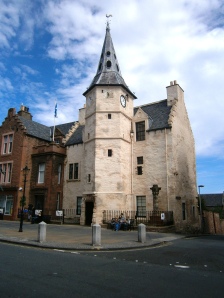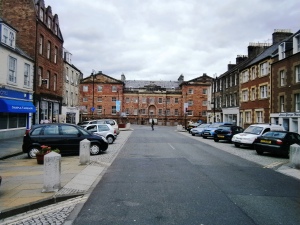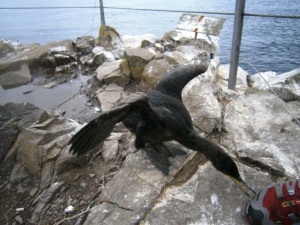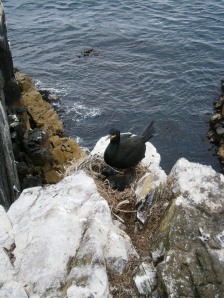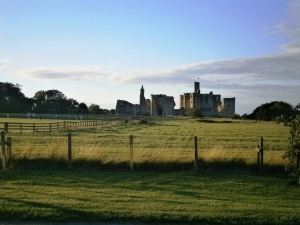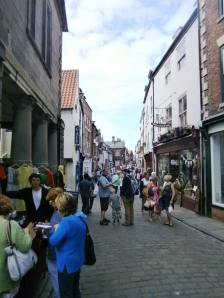Wednesday 7th August – Dunbar to Eyemouth

Dunbar harbour at low tide. The locals seem to be happy letting their boats lean over and re-float as the tide rises.
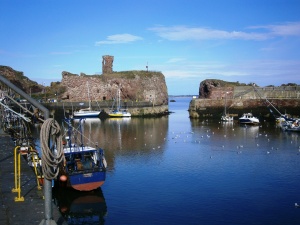
Sundart secured against the wall at low tide at Dunbar. The harbour entrance is to the right – blasted a hundred years ago through the rock and old castle walls. The kittiwakes were nesting in the castle wall above Sundart.
Pam Deacon will join us early this afternoon, which works out well with the tides for going south. The tide is out so Sundart is standing on her keel on the sand in the bottom of the harbour, propped up against the wall with a rope round the mast to stop the boat falling over. Other boats have gone over on their sides.
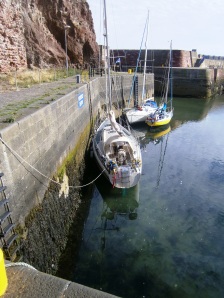
Against the wall at Dunbar. Access is via the vertical ladder up the harbour wall – not so great if you get caught out at night!
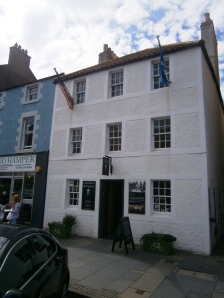
The birth place of John Muir and now a museum dedicated to him. Muir is best known for setting up the National Parks in the USA. He was a great lover of the natural world. Muir Woods in California, just north of San Francisco, is a magnificent forest of giant redwoods named in his honour.
We do chores in the morning and catch up on the blog and diary. The kittiwakes are very busy this morning, coming and going and causing much interest. The tide gradually comes into the harbour, lifting the boats up from their sides. A large seal comes swimming into the harbour.
Around midday we walk up into Dunbar for a few bits of shopping. Dunbar seems a nice little town with a proper High Street, mainly comprising of Georgian and Victorian houses set back from the road.
We walk past John Muir’s birthplace, which is now a museum in his honour. John Muir was a keen naturalist who emigrated to the USA from Dunbar and founded the National Parks there. He is commemorated in the USA by the Muir Woods just north of San Francisco – a forest of magnificent redwood trees, some of the tallest trees in the world. We have visited these woods and have now seen the start of that story. John walks up to the station to meet Pam whilst Yvonne (who has a painful knee) walks back to the boat. John passes the Town House, another museum on the High Street that is about old Dunbar but it is shut.
Pam arrives and we walk back to the boat, passing the fine, new swimming baths and sports complex that overlook the harbour.
After lunch we leave via the amazing harbour entrance and set sail down the coast towards Eyemouth, our last stop in Scotland. It is a fine day with a breeze from the south so we beat down the last of the Firth of Forth and round St. Abb’s Head, with its cliffs and rock stacks. The wind falls so whilst John cooks vegetarian curry for supper, Pam and Yvonne take the boat down to Eyemouth. The entrance is fairly easy to find and negotiate and we call up the harbour master to get our berth allocation. As we pass through the high walled passageway into the harbour (known locally as the “canyon”) we pass several seals flopped out on the rocks, idly watching the passing boats. We moor up alongside a Dutch couple in their boat “Rascal”, who have also been sailing round the UK, albeit via the Caledonian Canal. Supper is ready once we have moored up at around 8 pm.
A good day and a pleasant sail.
Ship’s log
Day’s run: 25.6 nm
Total miles to date: 1737.9 nm
Engine hours: 1.7 hours
Total engine hours: 207.1 hours
Hours sailed: 5.3 Hours
Total hours sailed; 381.7 hours
Thursday 8th August – Eyemouth to the Farne Islands

The harbour at Eyemouth. Still an active fishing port where leisure and working boats mix amicably. The local harbour master and his staff are extremely helpful.
Another fine sunny day. As the south going tide does not start until the afternoon we have the morning in port. This still means some chores so Yvonne & Pam sort out the laundry at the excellent port facilities whilst John pays the harbour dues and gets chatting to the harbour master. He is extremely helpful and provides a copy of the sailing directions for the Farne Islands by the Northumberland Cruising Club. (We found that the Clyde Cruising Club directions for the Orkneys and the North of Scotland have been the best sailing directions we have used and the Northumbrian version is to the same high standard). The people at the Port of Eyemouth run a busy fishing port as well as providing an excellent welcome and facilities for leisure sailors – it’s a smart move that wins on all fronts.
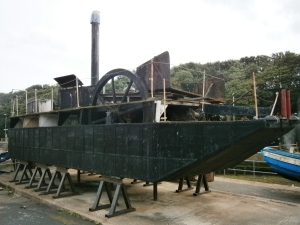
“Bertha” – the oldest steam driven boat in Britain. Designed by Isambard Kingdom Brunel in 1844 and used for over 120 years, it was the Bridgewater harbour “scraper” – used to scrape mud from the harbour floor and deposit in the River Parret to be washed out to sea. The boat operated by a system of chains, not propeller or paddle wheel. It is now owned by the Eyemouth International Sailing Craft Association and is part of the National Historic Boats Register.
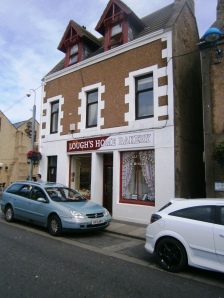
It is possible to eat very well in the UK without having to go “foreign” – this is Lough’s Home Bakery in Eyemouth where they bake all their own product.
Jobs done we wander into Eyemouth. This is quite an attractive fishing post with a busy fish industry on the quays and a decent village behind. We find an excellent bakery and buy what is possibly the best almond cake/tart that we have ever tasted. Sadly, we have already stocked up on bread so have no room for the home baked variety here. We also find a proper little fish shop and buy a mixture of fish for a fish pie (Yvonne’s speciality). They are selling samphire – a delicacy that grows on salt marshes; it is bright green like tiny soft asparagus tips and is very tasty and nutritious. (This bunch came from Norfolk).
At two o’clock the tides are right and we leave Eyemouth, bound for the Farne Islands. Once again, we have the wind against us so we beat down the coast. The wind comes and goes, necessitating the use of the “iron sail” from time to time. It is an attractive coast with high cliffs and hills behind them. The East Coast mainline and the A1 road run along the top of the cliffs for much of the way down to Berwick on Tweed. We decide that a conspicuous hedge down some fields marks the division between Scotland and England so we ceremoniously lower the Scottish saltire pennant that has been fluttering from our flag halyard all these weeks.

The distant Northumbrian coast as seen from the Farne Islands. Bamburgh Castle is on the skyline, overlooking the shore whilst the Cheviot Hills are in the far distance. This is some of the best coastline in the UK with long sandy beaches and little habitation.
We sail on, passing the mouth of the River Tweed and Berwick and also passing from sea area Forth into sea area Tyne. We carry on down the coast, the wind increasing a bit as we pass by Holy Island and the ruins of Lindisfarne Priory and the castle. Lindisfarne Priory was founded in AD 634 and was subsequently sacked by the Danes in the 9th Century but the magnificent Lindisfarne Gospels survived and are now preserved in the British Museum. Although we could anchor at Holy Island, we have decided to sail five miles further south to the Farne Islands to enjoy the wild life there.
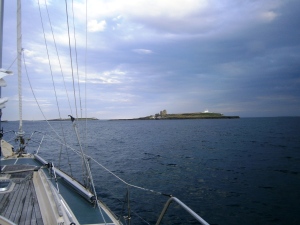
Approaching the Farne Islands. Inner Farne is nearest, with its Pele Tower and lighthouse clearly visible.
We press on and by 8 pm we are anchored in a natural lagoon known as “The Kettle” at the island of Inner Farne. This lagoon is sheltered on three sides by islands linked by rocky reefs. We dine on the excellent fish pie with crushed new potatoes and the samphire. It is a tasty meal, although the samphire is quite salty. All around us the area is busy with wildfowl, mainly terns and shags busy fishing, presumably to feed their young. We will explore the islands tomorrow.
Ship’s log
Day’s run: 26.8 nm
Total miles to date: 1764.7 nm
Engine hours: 2.5 hours
Total engine hours: 209.6 hours
Hours sailed: 6.0 Hours
Total hours sailed; 387.6 hours
Friday 9th August – Farne Islands to Amble
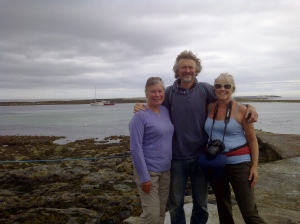
On Inner Farne Island with Pam Deacon. Sundart is anchored in the “Kettle” – a sheltered pool – in the background. We had peace and quiet in the evening with just thousands of birds around.
We sleep well and awake to the superb setting and wonderful views we have in this anchorage. After breakfast we decide to go ashore before the trip boats arrive so we inflate the rubber dinghy and paddle to the old quay. The islands are a Nature Reserve and are administered by the National Trust. Landing is only permitted on Inner Farne, Staple and Longhope Islands out of the fourteen or so islands. Being NT members means no landing fees for us.
The rangers are all young and very friendly and helpful. They help us identify the birds and explain where the nests are. There are all four types of terns found in the UK here – common, arctic, sandwich and roseate. Sandwich terns are parading on the beach – it appears that they may have a second brood this year as it has been a good year with plentiful supplies of their staple diet of sand eels and kindly weather. Sandwich terns apparently pair up for several years.
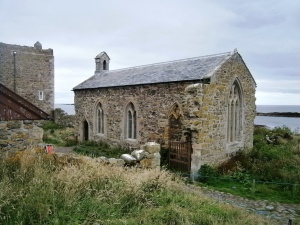
St. Cuthbert’s Chapel on Inner Farne. St. Cuthbert lived a hermit’s life here around 676 to 685 until called to be the prior at nearby Lindisfarne Priory. He returned later and died on the island. This chapel was built in the 14th century and was restored in the 1840’s.
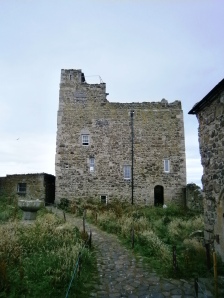
Pele Tower on Inner Farne. These towers are a feature of the north of England and most are a relic from the days when there was open warfare between Scotland and the English under Edward I. The towers were built by the locals to withstand short term siege and were self-contained with battlements on top to rain down arrows and missiles on unwanted visitors. This tower was built in 1500 and whilst being used as a fort was home to the grandly titled “Captain of Holy and Farne Islands”. It fell out of use in the late 1600’s and is now home for the National Trust wardens on the Farne Islands.
We walk up to the chapel of St. Cuthbert, the hermit monk who lived here for eight years around AD 676 in a stone and turf cell. He stayed there until summoned to be the Prior of Lindisfarne, which he reluctantly did, returning to Inner Farne later in life where he apparently died. Next to the Chapel is the Pele Tower known as Prior Castell’s Tower, typical of the northern borders of England with Scotland, where such sturdy stone towers were used for defence against maraudering Scottish reivers around the 15th and 16th centuries.
There are young terns everywhere that seem to have no fear of humans, being totally focused on getting the next meal from their hard pressed parents. It can’t be long before the parents leave them to fend for themselves. We walk on up to the Lighthouse at the western tip. We can see the Northumberland coast line with the majestic Bamburgh Castle nearly five miles away across the water. There are cliffs at this end of the island with shags, kittiwakes and fulmars nesting. The offspring are nearly full grown with appetites to match.

Juvenile shag. Most of the young birds we saw in August were getting near the time for them to leave the nest. At this stage the parents have a hard time keeping up with their off-springs’ appetite.
A young shag decides that Pam’s red shoes look like a tasty meal and follows her around, pecking the shoes – Pam is absorbed with getting close up photos before she realises the shag’s intentions! There are a few puffins left with their young, although the main cohort has left by now for the open sea where they live for ten months out of twelve. Sea birds are remarkably tough when one considers where they live for most of their lives. The trip boats start to arrive so we decide to return to Sundart.
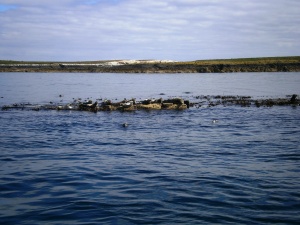
Seals basking on a rock in the Farnes. They will start to pup in about a month or so time so they build up their food reserves in their bodies at this time of year… and rest up..

Longhope lighthouse, Farne Islands – home of Grace Darling and her father, the lighthouse keeper, when they performed their heroic rescue of the crew of the SS Forfarshire in 1838.
Before setting off for our next port at Amble, we motor round the islands as the sea is calm,, seeing many seals on the rocks. The seals will give birth to their pubs in a month or so time so they are building up their strength, ready for parenthood.
The easternmost island is Longhope where Grace Darling lived with her father, the lighthouse keeper. Grace and her father became overnight heroes to the Victorians after the courageously rescued some of the shipwrecked passengers of the SS Forfarshire in 1838. Sadly, Grave died aged 26 of TB. She was always embarrassed at the attention she received.
We set off south to Amble, the wind sets in and we have a lively sail down the magnificent Northumberland coast, passing the ruins of Dunstanburgh Castle looking imposing on its headland and arriving at Amble at around half past four.

The memorial stone to Grace Darling in St. Cuthbert’s Chapel, Inner Farne. She died of TB about two years after her heroic life-saving deeds. She was embarrassed by the attention she got from the Victorian media and public.
Pam is leaving us here as her son Jono and daughter-in-law Megan live nearby with their two young daughters. Megan and girls duly arrive and after coming on board depart with Pam. A little while later Pam phones us with and invitation to share a take-away curry at Megan and Jono’s home. Jono is on night duty at his veterinary practice so we sadly won’t meet him but we accept the invitation with pleasure.

Megan Deacon exercising the dogs in the river at her and Jono home at Warkworth, Northumberland. The river is semi-tidal, hence the sandy beach.
Jono was a very active member of the Staunton Harold Sailing Club in his youth when the Deacon’s lived in the East Midlands so we know him well. He has established his own, very successful practice outside North Shields and lives with his family at Warkworth, by the River Coquet just inland from Amble in a delightful spot with fields for Megan’s horses and a section of the river bank.
Despite Jono’s absence we have a very pleasant evening before being returned to Sundart. Another good day.
Ship’s log
Day’s run: 19.6 nm
Total miles to date: 1791.3 nm
Hours sailed: 4.1 Hours
Total hours sailed; 391.7 hours
Saturday 10th August – Amble to Tynemouth

The centre of Amble. Once a port devoted to exporting coal, it has had to re-invent itself since the decline of the coal trade.
We can’t depart from Amble until 3.30 pm as there is a cill at the marina entrance (to maintain the marina water level at low tide) and we need the south going tide. Yvonne does another laundry run whilst John attacks the blog. We then walk into Amble to do a bit of shopping and see what Amble is about.
The harbour (originally known as Warkworth Harbour) was originally set up on the estuary of the River Coquet to export coal. The demise of that industry in the 1960’s meant that Amble has had to find other occupations whilst the harbour has become the marina with some quay sides along the river for fishing boats.
Once we are able to leave Amble Marina, we have an excellent sail down the coast. The wind is in the west and a good strength so we initially set a couple of reefs and reach down the coast. We are going so well that we decide to by-pass our original stopping point at Blythe and carry on to the River Tyne. As time goes by the wind reduces a bit and we shake out the reefs and happily sail on.
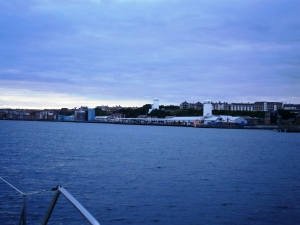
The entrance to the River Tyne by the fish dock. The two large white towers are the leading marks to enter the river – the biggest such marks we have seen so far. (When ships are on the right course to enter from the sea the two towers are lined up).

The entrance to the Tyne at Tynemouth has some fine landmarks, including the ruins of Tynemouth Monastery and the statue of Admiral Collingwood, Nelson’s second in command at Trafalgar and Tyneside’s most famous son of the sea.
We reach the entrance to the Tyne at around half past seven. The Tyne is, of course, a major river but we are surprised at the size of the entrance with some very substantial breakwaters on each side and the biggest leading marks we have seen. On the north shore (the North Shields and Whitley Bay side) we can see the imposing ruins of Tyneside Abbey on the headland and the statue of Admiral Collingwood.

The Tyne is still a busy river with commercial traffic. We met this huge Ro-Ro ferry complete with tugs and pilot boat as we went up the river by North Shields. We like to think it was full of cars for export from the Nissan plant at nearby Sunderland.
We are initially surprised at how quiet the river is but as we round a bend we are confronted by a huge Ro-Ro ship being tugged down the middle of the river – we hug the right bank as it slowly passes by.
We soon reach the Royal Quays Marina at North Shields and lock in. The marina attendant takes our lines for us, then works the lock and then runs round to take our mooring lines at the pontoon – very impressive service! This marina is in a huge old stone built harbour basin and is run by the same people who run Neyland Marina at Milford Haven so we are not surprised by the level of service.
Ship’s log
Day’s run: 21.4 nm
Total miles to date: 1812.7 nm
Engine hours: 1.2 hours
Total engine hours: 213.7 hours
Hours sailed: 5.0 Hours
Total hours sailed; 396.7 hours
Sunday 11th August – North Shields to Hartlepool.
We plan to leave at lunchtime to take the tide down the coast to Hartlepool so we have the morning free. John does the routine engine checks then we walk up the hill to the nearby village shop for a Sunday paper.

Royal Quays, North Shields was formerly known as Tyne Commission Quay (the name still lingers on as the car park name). John remembers catching the ferry to Norway from here over 25 years ago when the train delivered passengers direct to the ship side. Ferries still ply to Scandanavia from here, such as the DFDS ferry to Denmark moored on the left. The Royal Navy corvette HMS Severn is also moored there: this vessel and her sister ship are employed on coastal patrols and fishery protection work.
John thinks that this area was once known as the Tyne Commission Quay, from where he sailed to Norway on several occasions in his teens, arriving at the dockside by train direct from Kings Cross, London. We check with the Marina Manager who confirms this, showing us old photos of the Quay. The marina is built in the old docks once used for coal export. There has been considerable rebuilding and renovation all around the area with many new houses. Across the river at South Shields we can see new offices, an Asda and more houses. Clearly there has been a huge effort to regenerate this area and it appears to have paid off. We wander over to the riverside where we can see that a Royal Navy corvette has just moored up. This is HMS Severn, which is engaged with her sister ship on coast patrol, fishery protection, surveillance and general coastal security. Just up stream is a huge DFDS ferry, so ferries still ply from here to Scandinavia. The quays are now known as the Royal Quays. Only the car park retains the old name of Tyne Commission Quay. It starts to rain so we run back to Sundart, and read the Sunday papers until lunch.
We book our exit time from the lock and leave at half past two. It is much windier today than yesterday so after taking a photo from the river of the old TCQ we set part of the genoa, run out of the river and set course to reach down the coast. It is a fast and exhilarating sail, travelling at up to 7.5 knots, using just part of the foresail for motive power. The sea is relatively flat so we make excellent progress, passing Sunderland (where we can see the Stadium of Light) and Seaham. (In recent times Sunderland has been known for ship building, football and most recently Nissan cars but it was also where the monk, the Venerable Bede lived in the 7th century).
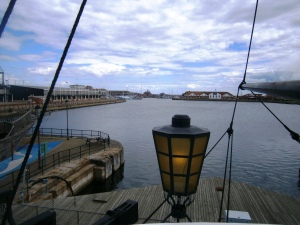
Hartlepool formerly had a huge expanse of dockyard. This is the old dock, with the marina at one end and the Maritime Heritage museum at the other and a large expanse of water little used in between. There remains a commercial port but in a different area and with its own entrance from the sea adjacent to this. The task of rejuvenating this area has been immense and although it is now tidy and has had much investment there remain plenty of empty spaces.
As we get near Hartlepool we see the old town with attractive painted cottages along the sea front. There is a “tidal gate” at Hartlepool as the entrance to the harbour and marina dries out but we arrive in good time, locking into the marina by 7pm. The harbour basins are huge, with a separate basin with its own approaches for the remaining commercial traffic and the basin we are in. We later find out that this was a big boat building area. The marina occupies part of the basin and in the distance the Marine Heritage Centre occupies another part but there is a lot of empty space – there must have been a lot going on here in past times.
Ship’s log
Day’s run: 21.5 nm
Total miles to date: 1834.2 nm
Engine hours: 1.2 hours
Total engine hours: 214.9 hours
Hours sailed: 4.0 Hours
Total hours sailed; 400.7 hours
Monday 12th August – Hartlepool to Runswick Bay
It’s afternoon tides again so we decide to explore the immediate vicinity.

Residents of Hartlepool are known as “Monkey Hangers”. The story is that in the Napoleonic Wars a Portuguese ship called in and being a foreign ship was detained by the locals who believed that all foreigners were enemies. Portugal was Britain’s only ally then but despite the mayor’s intervention the townspeople insisted on hanging a member of the crew so the Portuguese offered the ships monkey who was duly hanged with ceremony and honour was apparently satisfied all round.

As with so many ports, Hartlepool is much smaller than formerly. This the fine old Harbour Office, now converted to flats.
The old town is about 3 miles away so we opt to walk round the harbour to the Maritime Heritage Centre. As with so many of these old harbour basins there has been a lot of redevelopment around it, using the waterside to its best advantage. Much has been done here (although there remain quite a lot of open areas just grassed over or in use as car parks). The redevelopment has been well done, with some of the old buildings rejuvenated and turned into flats or offices.

The restored HMS Trincomalee is the centrepiece of the Maritime Heritage Centre at Hartlepool and forms part of the rejuvenation of this old port area.
The Maritime Heritage Centre is focused around HMS Trincomalee, a 3 masted frigate dating from 1817. For the second time this trip we are presented with a ship that claims to be the oldest British warship afloat. (Only the USS Constitution is older in the world).

HMS Trimcomalee – fully restored by 2005 and now claimed as the oldest warship afloat in the world – a claim disputed by HMS Unicorn (Dundee) and USS Constitution (USA). Either way, it is a beautifully restored ship and well worth the visit.
Remarkably, this ship is the same class (the Leda class) as the Unicorn at Dundee but was built in Bombay at the Wadia shipyards from teak as oak was becoming in short supply in England following the Napoleonic Wars. (The Unicorn was built in 1824 from oak in the naval dockyards in Chatham). Like Unicorn, this ship was put into the reserve but unlike the Unicorn, Trincomalee was later put into active service, being fully fitted out and serving two commissions, keeping the “Pax Britannica” in Canada, the Caribbean and the Pacific before being retired in 1857. From then until 1897 the ship was used for training in various locations before being sold for scrap. By chance, the privately owned TS Foudroyant had just sunk so its owner, Wheatley Cobb, snapped up Trincomalee as a replacement. She was used for training until 1986, when demand for naval type training dwindled. It was decided to restore the ship, a Trust was formed and funds gradually raised. The ship was taken to Hartlepool on a floating dock and floated into the old graving dock that is now the centre of the museum. All the restoration was done there using local skilled labour, being finally completed in 2005 at a cost of £10.2 million.

The figure-head and cats head – ornately carved as was the style of the day. The figurehead is said to be modeled on the head of the Wadia family, shipwrights of Bombay who built this ship to the Admiralty Leda class frigate design.

The origin of the term “copper bottomed investment”: copper plates were fixed to many wooden ships to deter marine growth and help preserve the timbers as copper has bactericidal properties. Trincomalee was re-tarred and copper plated as part of the restoration.

All the masts and rigging were replaced during the restoration, although the masts are actually galvanised steel, not timber. The signal flags read “Welcome to Trincomalee”.

The captain’s quarters. In the Navy, the Captain traditionally did not mix with the officers to any great degree whilst the actual sailing of the vessel was organised by the ship’s master.
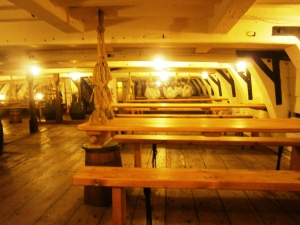
The Lower Deck where the crew lived in cramped conditions. Part of the Navy discipline included daily cleaning of the ship, a factor that helped enable the British to keep their ships at sea over long periods, even though the quality of the food left much to be desired due to the limited means of preservation then available.

The Wardroom, where the officers lived. The officers’ cabins open up off this room – a system still in practice a hundred years later on the RRS Discovery which we saw in Dundee.
The ship has been magnificently restored, complete with new rigging (albeit with steel replica masts that look like the originals) and period artefacts. The photos show some of the results.
We wander round the period style buildings around the dock with their heritage displays and video presentations before exploring the ship then returning to Sundart for a late lunch.
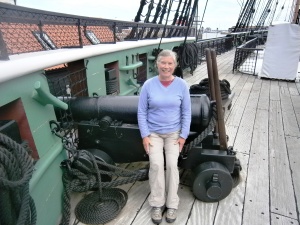
A lot of the cannon are fibre-glass replicas but Yvonne sought out one of the few real cast iron canon on board with the monogram of King George cast in the barrel.
More information can be found at More about Trincomalee.

The Wingfield Castle – a product of the ship builders who were formerly at the graving dock that HMS Trincomalee now occupies. Its sister ship, the Tasttershall Castle, is on the Thames being used as a restaurant.
John has found that it is cheaper to buy diesel here in cans rather than direct from the marina pump (some tax arrangement that we don’t fully understand) so manages to acquire a redundant diesel can and tops up the fuel.

The former Corus steelworks at Redcar – one of the few remaining steel production sites in Britain. The blast furnace was mothballed two years ago by its then owners, Tata, before its sale to a Thai company who re-commissioned it at great expense in April. The plant is losing money due to poor worldwide demand for steel and ruthless Chinese competition.Rain clouds approaching!

The little village of Staithes with its tiny harbour in front. This was Captain Cook’s birthplace. The houses and narrow streets cling to the steep hillsides. Cars have to stay parked on the top. The North Yorkshire Moors stretch out behind.
The marina manager at North Shields recommended an anchorage at Runswick Bay, east of here just before Whitby so we decide to take the first lock out of Hartlepool on the afternoon high tide at 4 pm and sail down the coast. In the distance we can see the Corus steelworks at Redcar, one of the few remaining steel making operations in the UK. Merchant ships which are anchored up off the coast to the east of Hartlepool start to get called into the port of Middlesbrough up the River Tees as the tide rises and the port authority calls them in so we have to avoid them as they need to follow the shipping lanes. We have to skirt round a new wind farm off Teesside that is so new it is just being commissioned and did not feature in the chart corrections we did over the winter.
The wind is fickle so we sail and motor intermittently, passing Maersk-by-the-Sea, Saltburn-by-the Sea and Staithes (the birthplace of Captain Cook and now a pretty little fishing village with a tiny harbour and houses perched up the steep hillside). We also pass Boulby, site of a potash mine that is the one of the deepest in Europe at over 1 km below ground and 2 miles under the sea. (It was recently used to hunt for the mysterious quark by astro-physicists as most particles from outer space do not penetrate that deep into the earth). There are some strange cloud formations and spats of rain but these blow by out to sea.
We reach Runswick Bay and anchor by a couple of other boats opposite the village. (During the 1680’s the original village slipped into the sea: the modern village consists of houses wedged into the unstable hillside). Although there is now little wind and calm is forecast, there is a swell coming into the bay. We hope it will die down overnight.
Ship’s log
Day’s run: 16.0 nm
Total miles to date: 1850.0 nm
Engine hours: 3.4 hours
Total engine hours: 218.3 hours
Hours sailed: 4.0 Hours
Total hours sailed; 404.7
Tuesday 13th August – To Whitby

The entrance to Whitby harbour. This is the only natural harbour on this stretch of coastline. Whitby Abbey ruins are a distinctive landmark on the south headland. The swell made the entry exciting!
The boat rocked all night in the swell so we are up at 0600 and decide to decamp to Whitby, five miles down the coast. Whitby marina is in the inner harbour which has to be entered past a swing bridge within two hours of either side of high tide. Happily, we can get in from 0800 so we set off. It is a beautiful morning as we skirt the coast, past Sandsend (where the mineral jet can be found which is worked into jewellery) to the harbour entrance. There is still some swell running and the entrance is a bit rolly-poly – we simply rev up the engine and pass in without difficulty into the calm within the outer harbour.

The fine Edwardian iron swing bridge at Whitby. Opening every half hour near high tide preceded by a clanging of a hand bell. Recently restored to its former glory.

The view of the town from the marina. Whitby seems to have been able to blend old and new houses together in an attractive way, keeping to traditional materials in the main.
Whitby is the only natural harbour down this length of coast and has had an established harbour for hundreds of years. It is a pretty town, with many 18th century red brick and tiled houses up the steep sides and the very imposing ruins of the abbey on the south headland. Newer houses seem to have been designed to fit in with this style and colour of building whilst the old shop fronts have been retained. A call to the marina reveals that it is full so we have to tie up just below the swing bridge to await some boats coming out. It was their regatta night last night with fireworks on the front so the town is in clean up mode. Eventually, we are allowed in at 0900 and after radioing the bridge keeper to open the bridge we pass through the lovely Edwardian iron swing bridge and moor at the marina.

Like many smaller ports, Whitby has kept some local ship repairing and building. This fishing boat is lodged in a floating dock undergoing renovation. The notice on the shrouding in the background proclaims that they are keeping their tradition alive, building a new boat under the scaffolding and sheeting.
After showering at the new and very smart facilities we walk over to the big Co-op superstore opposite to stock up. Whitby is in full holiday mode – crowds of people milling about in the warm sunshine, coaches depositing their tour passengers all down the street, a steam train from the North Yorkshire Moors Railway puffs into the station and quantities of fish and chips and ice cream being consumed. It’s a proper English holiday place in full swing. Yorkshire accents surround us – we are in proper Ecky Thump Country! (Accents have probably changed more as we travel down the north-east coast from Scotland than perhaps anywhere else).
Shopping done and lunch eaten, we set of to explore Whitby. Progress is slow due to the crowds but there is plenty to look at as we wander along.
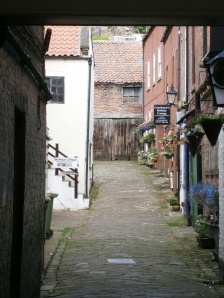
There are delightful alleyways off the main streets in old Whitby with the old cobbles and converted stabling.
We cross the river Esk via the swing bridge to the oldest part of town on the south side and come across the Captain Cook Memorial Museum by the river.

The Captain Cook Museum is located int he house where he was apprenticed to John Walker to learn his craft. The apprentices were housed in the attic. The Walkers were Quakers and had a reputation as firm and fair with high standards but they were not interested in the fancier side of life. Cook learnt much here and remained friends with his former employer throughout his life.
As is well known, Cook was one of the greatest explorers and cartographers to have come from Britain, having been responsible to charting as diverse a span of territory from the St. Lawrence River in Canada (where he enabled General Wolfe to capture Quebec and thus make Canada British) to the north-west passage, Australia, New Zealand, many of the Pacific Islands and even bits of Antarctica. He learnt his sea-faring trade on colliers operating out of Whitby as an apprentice to Captain John Walker, lodging in Walker’s house with the other apprentices in the attic of the house that is now the Cook Museum.
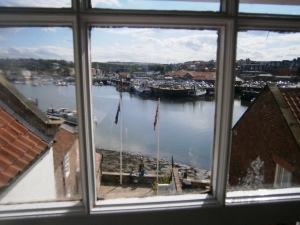
The view over the River Esk from the Captain Cook Museum. This is the outlook that Cook would have had when an apprentice living in this house, learning his seamanship. His master’s ships would have been drawn up on the hard below the house.
The house is a fascinating collection of letters, maps, artefacts collected from Cook’s travels and information on Cook’s life and times. Cook remained friends with John Walker even after he went on to great things and there are many samples of their letters. (Cook is just one of very many people who have made significant contributions to the welfare and prosperity of Britain who was not honoured by any form of official recognition such as a knighthood. One could add many others to that list – other explorers such as Livingstone, Scott, Shackleton, engineers such as the Stephensons (of both railway and lighthouse fame), Brunel, and so on. Yet to this day anonymous politicians and civil servants get the bulk of honours).
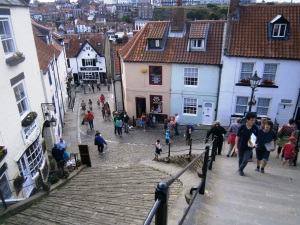
The climb to the Abbey is up 199 steep steps out of the old town. The road to the left was presumably for pack horses, not carts!
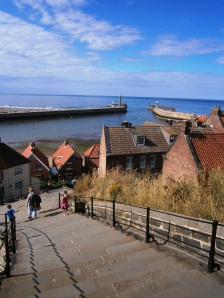
The view out to sea at Whitby. Not much will have changed since James Cook’s day – perhaps a couple of new houses and additional lights at the harbour entrance.
We finish the Cook Museum and as we are now rather “nautical museumed-out” we buy ice creams and walk up the 199 steps to Whitby Abbey.
The Abbey buildings date from the 13th century and are said to be the inspiration for Bram Stoker’s novel Dracula. This is the second place down this coast that we have come across this claim – perhaps the tourist industry assume tourists don’t travel as far as us! The Abbey was dedicated to St. Hilda and housed both nuns and monks and produced nine saints, five local bishops and the Saxon poet Caedmon. St. Hilda was one of the greatest Christian leaders of her time, her successes include persuading the church to adopt a unified way of calculating when Easter should be and for bringing together the Celtic and Roman branches of the Church. The view from the hill by the Abbey is superb but we decide we have done enough visiting today and do not go into the abbey remains or museum.

The ruins 13th century Abbey dedicated to St. Hilda are said to have been the inspiration for “Dracula”.

The inner harbour and marina as seen from the Abbey Hill. The town was by-passed in the 1980’s by the high bridge in the background.
We finish our ice creams and return to the boat. We have been in contact with Philip and Lorna Laughton, John’s brother and sister-in-law from his first marriage to Ann, who live at Saltburn to arrange to meet up with them this evening. They arrive around seven so we have drinks on board before repairing for fish and chips at the Shambles, an eatery housed in the former Burberry factory by the waterside in the old part of town. It has been quite a few years since we last got together so there is much to catch up on. Their eldest daughter, Sarah, will get married to Ian next June so they are getting into wedding mode. We round off the evening with coffee back on board. After Philip and Lorna leave we soon crash out for a good night’s sleep. Tomorrow we plan to continue down the coast to either Scarborough or Bridlington.
Ship’s log
Day’s run: 5.1 nm
Total miles to date: 1855.3nm
Engine hours: 1.3 hours
Total engine hours: 219.3 hours
Hours sailed: 2.0 Hours
Total hours sailed; 406.7 hours
A following wind and fair weather to you all.
Yvonne and John


